
Warwick Camp (Bermuda)
Encyclopedia

Bermuda Regiment
The Bermuda Regiment is the home defence unit of the British Overseas Territory of Bermuda. It is a single territorial infantry battalion that was formed by the amalgamation in 1965 of two originally voluntary units, the all white Bermuda Volunteer Rifle Corps and the mostly black Bermuda Militia...
. The base was located on a strip of land obtained during the mid-Nineteenth century by the War Office
War Office
The War Office was a department of the British Government, responsible for the administration of the British Army between the 17th century and 1964, when its functions were transferred to the Ministry of Defence...
along the south shore of Warwick
Warwick Parish, Bermuda
Warwick Parish is one of the nine parishes of Bermuda. It is named for Robert Rich, 2nd Earl of Warwick .It is located in the central south of the island chain, occupying part of the main island to the southeast of the Great Sound, the large expanse of water which dominates the geography of western...
, in Bermuda
Bermuda
Bermuda is a British overseas territory in the North Atlantic Ocean. Located off the east coast of the United States, its nearest landmass is Cape Hatteras, North Carolina, about to the west-northwest. It is about south of Halifax, Nova Scotia, Canada, and northeast of Miami, Florida...
. The army garrison in Bermuda was being re-organised, with the headquarters moving from St. George's
St. George's Parish, Bermuda
St. George's Parish is one of the nine parishes of Bermuda. It is named after the founder of the Bermuda colony, Admiral Sir George Somers.It is located in the north-easternmost part of the island chain, containing a small part of the main island around Tucker's Town and the Tucker's Town...
to Prospect Camp, near Hamilton
Hamilton, Bermuda
Hamilton is the capital of the British Overseas Territory of Bermuda. It is the territory's financial centre and a major port and tourist destination.-Geography:...
. Most of the Regular Army
British Army
The British Army is the land warfare branch of Her Majesty's Armed Forces in the United Kingdom. It came into being with the unification of the Kingdom of England and Scotland into the Kingdom of Great Britain in 1707. The new British Army incorporated Regiments that had already existed in England...
infantry relocated to Prospect Camp, also, leaving the St. George's Garrison largely in the hands of the Royal Regiment of Artillery. Prospect Camp was usefully located in the centre of the colony, and near the capital, but had no area suitable for a rifle range. In January, 1869, F Company of the 61st Foot was moved to Warwick to work on the Military Road (now, the South Shore Road), following which they constructed the rifle ranges at Warwick Camp. Two companies of the 15th Foot continued working on the road, west of Warwick Camp, and also built a new battery for the coastal artillery at Whale Bay.

Bermuda Volunteer/Territorial Army Units 1895-1965
The Volunteer Army units raised in Bermuda were created as part of an Imperial military garrison that existed primarily to protect the Royal Naval base, centred about the HM Dockyard on Ireland Island....
originally had no camps of their own, their sub-units being divided amongst a number of drill halls, or attached to the regular complements of coastal artillery batteries.
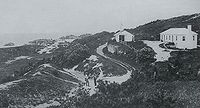
Royal Marines
The Corps of Her Majesty's Royal Marines, commonly just referred to as the Royal Marines , are the marine corps and amphibious infantry of the United Kingdom and, along with the Royal Navy and Royal Fleet Auxiliary, form the Naval Service...
(RM) detachment guarding the Dockyard
Royal Naval Dockyard, Bermuda
HMD Bermuda was the principal base of the Royal Navy in the Western Atlantic between American independence and the Cold War. Bermuda had occupied a useful position astride the homeward leg taken by many European vessels from the New World since before its settlement by England in 1609...
occasionally trained there, as did RM detachments from ships in the dockyard. During the Great War, the Bermuda Volunteer Rifle Corps
Bermuda Volunteer Rifle Corps
The Bermuda Volunteer Rifle Corps was created in 1894 as an all-white racially segregated reserve for the British Regular Army infantry component of the Bermuda Garrison...
(BVRC) and the Bermuda Militia Artillery
Bermuda Militia Artillery
The Bermuda Militia Artillery was a unit of part-time soldiers organised in 1895 as a reserve for the Royal Garrison Artillery detachment of the Regular Army garrison in Bermuda.-Foundation:...
were embodied in August 1914, and soon began planning to send contingents of volunteers to the Western Front. The first of these units was raised as a detachment by the BVRC, and embodied at Warwick Camp in December, 1914. Many of its members had enlisted specifically for the Front. The contingent trained full-time at Warwick Camp until it was dispatched to the Royal Lincolnshire Regiment
The Royal Lincolnshire Regiment
The Royal Lincolnshire Regiment was raised on June 20, 1685 as the Earl of Bath's Regiment for its first Colonel, John Granville, 1st Earl of Bath. In 1751 it was numbered like most other Army regiments and named the 10 Regiment of Foot. After the Childers Reforms of 1881 it became the Lincolnshire...
in Europe, in June, 1915. A second contingent was sent to the Lincolns by the BVRC the following year.
The Second World War
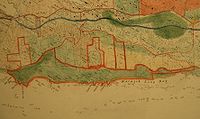
Bermuda Volunteer Engineers
The Bermuda Volunteer Engineers was a part-time unit created between the two world wars to replace the Regular Royal Engineers detachment, which was withdrawn from the Bermuda Garrison in 1928.-The Military Garrison in Bermuda:...
providing detachments to operate the search lights and provide signals. Warwick Camp continued to be used by all units in its training role, but also housed Territorial infantry units that had been embodied for the duration of the war.
After the Second World War
Following the War, the BMA and the BVRC were both reduced to skeleton command structures in 1946. The BVE, the Bermuda Militia Infantry (BMI), and the Home Guard were all disbanded. The BMA and BVRC (renamed the Bermuda Rifles) were both returned to strength in 1948. Their reason for existence, along with that of the entire garrison, soon disappeared, however, when most of the Royal NavyRoyal Navy
The Royal Navy is the naval warfare service branch of the British Armed Forces. Founded in the 16th century, it is the oldest service branch and is known as the Senior Service...
's dockyard was closed in 1950, leaving only a small supply base (HMS Malabar). Following this, the last Regular Army unit (a company of the Duke of Cornwall's Light Infantry
Duke of Cornwall's Light Infantry
The Duke of Cornwall's Light Infantry was an infantry regiment of the British Army from 1881 to 1959. Its lineage is continued today by The Rifles....
) was withdrawn in 1954. The previous year, the last battery of coastal artillery (the Examination Battery) was removed from use, and the BMA converted to the infantry role (although continuing to wear the Royal Artillery
Royal Artillery
The Royal Regiment of Artillery, commonly referred to as the Royal Artillery , is the artillery arm of the British Army. Despite its name, it comprises a number of regiments.-History:...
cap badge and uniform). 1953 was also the final year in which the Imperial Defence Plan, under which the two units had been tasked, was issued. Warwick Camp was among the lands that were slated for disposal by the War Office and the Admiralty, and which were taken over by the local government.
The Bermuda Regiment
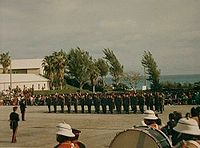
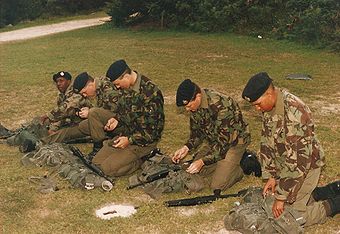
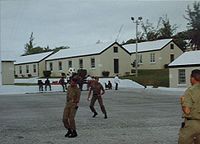
Bermuda Regiment
The Bermuda Regiment is the home defence unit of the British Overseas Territory of Bermuda. It is a single territorial infantry battalion that was formed by the amalgamation in 1965 of two originally voluntary units, the all white Bermuda Volunteer Rifle Corps and the mostly black Bermuda Militia...
. Warwick Camp has served, since then, as the Bermuda Regiment's headquarters and only facility. This actually compares very favourably to the situation of most Territorial Army units in Britain, which still operate from drill halls. They rarely have barracks, or any outdoor spaces except a small carpark that doubles as a parade ground. By comparison, Warwick Camp includes extensive lightly wooded and grassy areas, and full rifle ranges (fuller, in fact, than modern, sub-calibre rifles can make use of. The longest range used today is a 100 metre one, while the longest, which allows shooting at ranges of up to 800 yards, has long lain disused). There are also two 25 metre ranges - one on the south side of the road, and the other within the area enclosed by permanent buildings on the north side of the road (the South Shore Road, formerly the Military Road, which cuts through the camp, is a public thoroughfare, and the land to the south of it now doubles as public parkland). In addition to the ranges for live firing, the Camp also now has a building equipped with the Firearms Training System (FATS), allowing 'shooting' year-round in simulated combat conditions. The Camp has twelve barrack rooms, capable of accommodating a full rifle company, with support staff. The buildings housing the Officers' Mess and the Warrant Officers' and Sergeants' Mess both have rooms to accommodate commissioned officers and senior ranks separately from the lower ranks. The Corporal's Mess uses a dedicated barracks room for social activities, but junior NCOs are accommodated with their men (although they have a separate room within each barracks). There are large shower blocks, a large mess hall, and a small PRI. Each of the companies has its own office, and a connected Company Quartermaster (Sergeant's) Stores (CQMS Stores). The Regimental Headquarters is located in its own building, which also contains the armoury. The magazine for small arms, and other, ammunition is the actual magazine of the coastal artillery battery, the two 6" guns of which are still rusting atop the hill. There are separate buildings for the Regimental Quartermaster's Stores, Internal Security Stores, and for the Training Wing. There is space for the indoor storage of the two field guns of the Bermuda Regiment's ceremonial Gun Troop. There is also sufficient space for parking numerous vehicles, and for the storage of the Boat Troops rigid-hulled power boats. At the rear of the Camp, there is a small guard room, and several houses which are used to accommodate the Permanent Staff Instructor
Permanent Staff Instructor
A permanent staff instructor is a warrant officer class 2 , or senior non-commissioned officer , of the Regular British Army who has been selected to instruct Territorial Army soldiers...
s and other personnel seconded from the Regular Army, with their families. The last feature of Warwick Camp is a large parade ground, which is an important consideration, given the Bermuda Regiment's ceremonial commitments.
The facilities available at Warwick Camp, and its use by all elements of the Bermuda Regiment, mean that each rifle company is able to carry out virtually all types of training, from section battle drills, to range work, to IS training, on any given drill night or weekend Camp.

